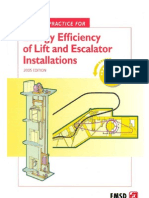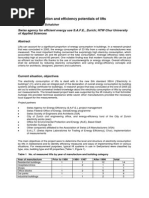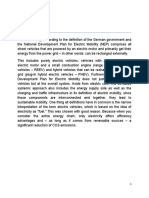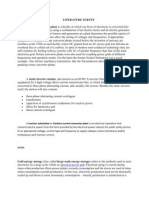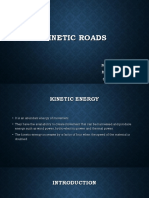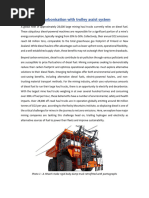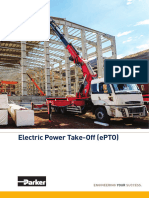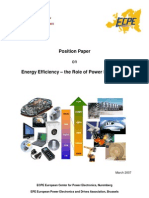0 ratings0% found this document useful (0 votes)
14 viewsKeywords: Dep. Electrical Engineering Coimbra, Portugal Carlospatrao@isr - Uc.pt Belgium
Keywords: Dep. Electrical Engineering Coimbra, Portugal Carlospatrao@isr - Uc.pt Belgium
Uploaded by
SammieLautnerThis document summarizes an energy efficiency project focused on elevators and escalators. It discusses the large number of elevators and escalators in Europe, their significant and growing electricity usage, and the high potential for energy savings through more efficient technologies. The project aims to characterize electricity consumption of elevators/escalators in different sectors and countries, identify barriers to efficiency, and promote best practices. Preliminary results are presented from auditing 10 elevators/escalators in Portugal to collect energy usage data.
Copyright:
© All Rights Reserved
Available Formats
Download as PDF, TXT or read online from Scribd
Keywords: Dep. Electrical Engineering Coimbra, Portugal Carlospatrao@isr - Uc.pt Belgium
Keywords: Dep. Electrical Engineering Coimbra, Portugal Carlospatrao@isr - Uc.pt Belgium
Uploaded by
SammieLautner0 ratings0% found this document useful (0 votes)
14 views11 pagesThis document summarizes an energy efficiency project focused on elevators and escalators. It discusses the large number of elevators and escalators in Europe, their significant and growing electricity usage, and the high potential for energy savings through more efficient technologies. The project aims to characterize electricity consumption of elevators/escalators in different sectors and countries, identify barriers to efficiency, and promote best practices. Preliminary results are presented from auditing 10 elevators/escalators in Portugal to collect energy usage data.
Original Description:
ee.esc
Original Title
dhir
Copyright
© © All Rights Reserved
Available Formats
PDF, TXT or read online from Scribd
Share this document
Did you find this document useful?
Is this content inappropriate?
This document summarizes an energy efficiency project focused on elevators and escalators. It discusses the large number of elevators and escalators in Europe, their significant and growing electricity usage, and the high potential for energy savings through more efficient technologies. The project aims to characterize electricity consumption of elevators/escalators in different sectors and countries, identify barriers to efficiency, and promote best practices. Preliminary results are presented from auditing 10 elevators/escalators in Portugal to collect energy usage data.
Copyright:
© All Rights Reserved
Available Formats
Download as PDF, TXT or read online from Scribd
Download as pdf or txt
0 ratings0% found this document useful (0 votes)
14 views11 pagesKeywords: Dep. Electrical Engineering Coimbra, Portugal Carlospatrao@isr - Uc.pt Belgium
Keywords: Dep. Electrical Engineering Coimbra, Portugal Carlospatrao@isr - Uc.pt Belgium
Uploaded by
SammieLautnerThis document summarizes an energy efficiency project focused on elevators and escalators. It discusses the large number of elevators and escalators in Europe, their significant and growing electricity usage, and the high potential for energy savings through more efficient technologies. The project aims to characterize electricity consumption of elevators/escalators in different sectors and countries, identify barriers to efficiency, and promote best practices. Preliminary results are presented from auditing 10 elevators/escalators in Portugal to collect energy usage data.
Copyright:
© All Rights Reserved
Available Formats
Download as PDF, TXT or read online from Scribd
Download as pdf or txt
You are on page 1of 11
ECEEE 2009 SUMMER STUDY ACT! I NNOVATE! DELI VER!
REDUCI NG ENERGY DEMAND SUSTAI NABLY 803
Energy efcient elevators and escalators
Carlos Patro
Dep. Electrical Engineering
Coimbra, Portugal
carlospatrao@isr.uc.pt
Joo Fong
Dep. Electrical Engineering
Coimbra, Portugal
joaofong@isr.uc.pt
Luc Rivet
Belgium
L.Rivet@ela-aisbl.org
Anbal de Almeida
Dep. Electrical Engineering
Coimbra
Portugal
adealmeida@isr.uc.pt
Keywords
elevators, lifs, escalators, energy ef ciency, stand-by con-
sumption, barriers and policies for energy ef ciency, elevator
drives
Abstract
Elevators and escalators are the crucial element that makes it
practical to live and work several foors above ground more
than 4,3 million units are installed in Europe. Due to ageing
of the European population the installation of elevators in sin-
gle family houses is experiencing a signifcant growth, as well
as equipping existing buildings. Elevators use about 4% of the
electricity in tertiary sector buildings. High untapped saving
potentials exist with respect to energy-ef cient technologies,
investment decisions and behavioural approaches, in these
sectors. Tis paper presents preliminary results from the IEE
project E4, whose overall objective is the improvement of the
energy performance of elevators and escalators, in tertiary sec-
tor buildings and in multi family residential buildings.
Te project is characterizing people conveyors electricity
consumption in the tertiary sector and in residential buildings
in the EU. Te installed park is characterised by a survey among
elevators national associations in each country. An assessment
of the barriers has been made in the frst phase of the project
and will be presented.
Monitoring campaigns in elevators and escalators are being
conducted in each country according to a common developed
methodology. More than ffy elevators and escalators will be
audited. Tis will allow the collection of load curves (start up,
travel up and down, travel full and empty), including the char-
acterization of standby consumption. Standby consumption of
an elevator can represent up to 80% of the total energy con-
sumed per year, and can be drastically reduced.
Tis paper presents the preliminary results of the frst ten
audits performed in Portugal by ISR-UC.
Introduction
In the EU-25 there are more than 4,3 million elevators and
85 thousand escalators and moving walks. Every year 125 thou-
sand new elevators and 5 thousand new escalators and moving
walks are installed [according to extrapolation of ELA-Elevator
market statistics 2005]. Terefore, it is very important to char-
acterize people conveyors (elevators and escalators) in terms of
electricity consumption and technologies in the tertiary sector
and in residential buildings in the European Union. It is nec-
essary to promote the ef cient use of electricity in this type
of loads through the application of cost-efective energy ef -
cient technologies available or emerging in the market. Energy
ef cient technologies can save a large percentage of the used
electricity in a cost-efective way. Te type of loads addressed
in this paper is growing fast due to the expansion of the built
area and because of the need to ensure adequate mobility to the
elderly and handicapped population.
Generally, hydraulic elevators used in relatively low-rise
buildings are much less energy ef cient than the electric trac-
tion elevators used in higher rise buildings, though new types
are being developed that match up to the energy ef ciency of
traction lifs. Earlier generation hydraulic elevators can use
3 times more electrical energy than traction elevators. Until
the year 1995 at least two thirds of all elevator installations were
hydraulic, then this trend began to change and in 2004 more
804 ECEEE 2009 SUMMER STUDY ACT! I NNOVATE! DELI VER! REDUCI NG ENERGY DEMAND SUSTAI NABLY
than 80% of all elevators sold were using traction technology
[Gemici, 2005].
Usually traction elevators have counterweights, which are
connected to the cabin by a pulley, and therefore it descends
when the elevator is rising, and vice versa. New technologies
and best practices namely motors and drives, regeneration con-
verters, better control sofware, optimisation of counterweights,
direct drives versus rope traction elevators, cabin lighting, etc.
can yield signifcant savings. Within a drive class the best per-
forming elevators can use up to 80% less electricity than the
least ef cient ones.
Electricity consumption in the tertiary sector in EU-25 by
2020 is foreseen to be 950TWh. Elevators and escalators now
represent 4% of the total electricity consumption in the tertiary
sector, with a trend for a signifcant increase of this share. Since
potential savings of over 50% are possible, the impact of this
project is the reduction of 20-25 TWh, translating into the re-
duction of 9-11 Mtons of CO
2
emissions. Additional savings are
possible in the residential sector, particularly in multi-family
buildings. Energy-ef cient elevator and escalator technolo-
gies can also lead to decreased maintenance requirements, less
downtime and increased safety.
The E4 project
Te E4 project [E4-Energy Ef cient Elevators and Escalators,
www.e4project.eu] is targeted at the improvement of the energy
performance of elevators and escalators, in the tertiary sector
(hotels, hospitals, schools, shopping centres, of ce buildings,
etc.) and in multi family residential buildings.
Te countries directly involved in the project are Germany,
Italy, Portugal and Poland, covering diferent regions of the EU.
Te European Lif Association (ELA) with agencies in most
EU countries also participates in the project, providing market
characterisation and together with other partners allowing a
large replication potential in other countries.
Te aim of this project is to characterize people conveyors
(elevators and escalators) electricity consumption in the terti-
ary sector and in residential buildings in the European Union,
and promote the ef cient use of electricity in this type of loads
through the application of the best available technologies in
the market.
Te main objectives of E4 project are:
to contribute to the market transformation of the service
sector buildings and residential buildings, by improving
the awareness of best practice solutions to provide vertical
mobility;
to provide recommendations and guidelines to promote
those practices;
to promote the improvement of energy performance of
elevators and escalators in the tertiary sector (hotels, hospi-
tals, schools, shopping centres, of ce buildings, etc.) and in
multifamily residential buildings.
In total, between the partners of the project, monitoring of
50 elevators and or escalators will be performed. Te monitor-
ing campaign will be carried out in a number of selected build-
ings of the residential and tertiary sectors. Tis paper presents
the preliminary results of the frst ten audits preformed in Por-
tugal by ISR-UC:
2 hydraulic elevators;
8 traction elevators;
2 escalators.
Figure 1. Electricity consumption breakdown in tertiary sector buildings in the EU [Source EC-JRC]
ECEEE 2009 SUMMER STUDY ACT! I NNOVATE! DELI VER! REDUCI NG ENERGY DEMAND SUSTAI NABLY 805
Elevators and Escalators
Elevators and escalator are systems used to provide vertical
mobility in good comfort conditions. Impressive technology
developments have been carried out in recent years in mo-
tors, electronic speed controls, mechanical transmissions, etc.,
which can dramatically reduce the electricity consumption of
this systems.
HYDRAULIC ELEVATORS
Te basic components of hydraulic elevators are shown in the
fgure 2.
Tis type of elevator uses a hydraulic cylinder to move the
car. An electric motor drives a pump which forces a fuid into
the cylinder moving the car up. When descending, an electric
valve opens and the fuid is allowed to drain (slowly) from the
cylinder into the tank.
Since they typically do not have a counterweight, the entire
potential energy is wasted as heat, making hydraulic elevators
less ef cient solutions, sometimes consuming three times more
electricity than traction elevators [Sachs, 2005]. Te most re-
cent hydraulic systems have now incorporated variable voltage
variable frequency drives (VVVF) and an accumulator that acts
as a hydraulic counterweight. Teir energy performance has
dramatically been improved with these new developments.
Hydraulic elevators are available for lifs up to a rated speed
of 1m/s. Te maximum travel distance for this type of eleva-
tors is around 18 m. Tis is due to the fact that as travel height
increases, larger diameter pistons have to be used to resist the
larger buckling forces. Tis increases the costs of equipment
and this way it is less attractive to use hydraulic elevators when
you have a better alternative [CIBSE, 2008].
TRACTION ELEVATORS
While hydraulic systems rely on pushing the elevator car up
and down, roped elevators pull the elevator cab using ropes
or cables. In traction elevators the car is suspended by ropes
rapped around a sheave that is driven by an electric motor. Te
weight of the cab is usually balanced by a counterweight that
equals the mass of the cab plus 45% to 50% of the rated load.
Te purpose of the counter weight is to maintain a near con-
stant potential energy level in the system as a whole, heavily
reducing energy consumption.
Tere are two main types of traction elevators: geared and
gearless (direct drive). Geared elevators use a reduction gear
between the motor and the sheave to reduce the speed of the
cab, while gearless elevators the sheave is directly coupled to
the motor. New technologies and best practices, namely en-
ergy ef cient motors and drives, better control sofware, opti-
misation of counterweights, direct drives instead of inef cient
gearboxes, cabin lighting, etc. can yield signifcant savings. Te
most ef cient systems have a Variable Speed Drive (VSD) that
can provide signifcant energy savings, by allowing regenerative
braking. Within a drive class the best performers elevators can
use up to 80% less electricity than the least ef cient.
ESCALATORS
Escalators, like moving walks, use an electric motor that drives
through a powertrain a system of moving steps.
Figure 2. Basic components of hydraulic elevators
Figure 3. Basic components of traction elevators
Figure 4. Basic components of an escalator
806 ECEEE 2009 SUMMER STUDY ACT! I NNOVATE! DELI VER! REDUCI NG ENERGY DEMAND SUSTAI NABLY
Escalators are moving steps design to transport people, over
a short distance, between two landings. Tey are driven by an
electric motor that powers the steps and handrail which move
at synchronised speeds. Te escalator is supported by a truss
which contains all the mechanical components, such as the
drive unit, brakes and chain.
Escalators typically travel at speeds of around 0.5 m/s fast
enough to provide rapid displacement while not disregarding
comfort and safety. Tey are used both in low rise building ap-
plications, such as one storey rises in commercial buildings,
and in high rise installations, such as in deep underground
metro stations.
SUMMARY
Te Table 1 presents a summary of the main applications, ad-
vantages and disadvantages of each type of elevator.
ELEVATORS MARKET ANALYSIS
Until 1998, hydraulic elevators were the most commonly in-
stalled solution, due to their low cost, security, low mainte-
nance costs, and very easy installation. At that time, hydraulic
elevators sales in Europe represented about 60% of total market
share. In 1995, with the appearance of the machine room-less
traction elevator this tendency begun to decrease [elik and
Korbahti, 2006].
Table 2 presents an estimation of the total installed elevators
and estimated market in 2005.
Europe is estimated to have more then 4.3 million elevators
installed, with Italy being the country with the highest number
of installed elevators followed by Spain and Germany. Te fg-
ure 5 shows the market share, in percentage, for each country.
Barriers
One of the aims of the E4 project is to help overcome some
important obstacles for investments and behavioural changes
which are mainly caused by socio-economic framework condi-
tions in the target sectors, but also market failures, transaction
costs, or imperfect information as well as market barriers on
the supply side:
Lack of awareness of building owners, investors and manag-
ers in private companies as well as public authorities, due to
Country
Existing elevators
in operation (2005)
Estimated market
(2005)
Austria 72.148 2.855
Belgium 77.000 2.722
CH (*) 164.220 6.791
Germany 631.000 11.450
France 475.000 11.604
Denmark 26.800 855
Finland(*) 50.000 840
Italy 790.000 17.900
Luxemburg 7.500 500
Norway 28.500 1.051
Netherlands 77.800 3.373
Portugal (*) 106.700 4.737
Spain 680.873 27.322
Sweden (*) 108.300 1.328
Greece (*) 308.000 8.475
Polland 70.000 2.000
Czech Republic 77.500 1.314
Hungary 32.950 1.000
UK 240.000 9.499
Total 4.189.191 115.616
(*) some of the values are estimated.
Table 2. Elevator market statistics [Source: ELA-Elevator market statistics 2005]
Type of elevator Typical applications Advantages Disadvantages
Hydraulic Low rise
2-6 floors
Low cost
Slow, high energy use,
maintenance issues
Traction
Machine room-less
Low-Mid rise
2-10 floors
Easy installation, energy
savings, faster then
hydraulic option
Higher cost than hydraulic
option
Traction
Geared
Mid rise
3-25 floors
Low cost for application Speed, energy
consumption
Traction
Gearless (direct drive)
High rise
over 25 floors
High speed High cost
Table 1. Summary of main applications [GIBSE, 2008]
ECEEE 2009 SUMMER STUDY ACT! I NNOVATE! DELI VER! REDUCI NG ENERGY DEMAND SUSTAI NABLY 807
the fact that the energy cost share is usually low, and invest-
ments in energy ef ciency do not afect the core business;
Large transaction costs, which generally include costs of
gathering, assessing and applying information on energy
savings potentials and measures, as well as costs to negotiate
with potential suppliers, consultants or installers;
Lack of information about energy consumption patterns
and therefore the proftability of energy saving measures
cannot be properly assessed, costs for metering and data
management, and investment costs for the metering devices
may prevent organizations from installing the appropriate
equipment;
Internal decision making and investment priority setting
depending on criteria such as pay-back time, but also on
sof factors such as the status of energy ef ciency, image, at-
titudes of those responsible for energy management within
the organization, or shared responsibilities between difer-
ent departments (operation/investments);
Split-incentives in building energy conservation, i.e. owners
of buildings who do not pay the energy costs, are typically
interested in low frst cost solutions.
Lack of suf cient market structures and access to energy
service companies, energy consultancies, energy agencies,
etc.
High cost of advanced emerging technologies due to lack of
economies of scale in their production.
Te project will address these barriers and will try to contrib-
ute to their removal through improved information and raised
awareness as well as stimulate adequate supporting policies.
Policies and Regulation
Environmental concerns have triggered, in the last decades, a
number of energy conservation policy measures that aim at
improving the worlds sustainability.
In 2005, the European Commission issued the Directive
2005/32/EC on the eco-design of Energy-using Products (EuP),
such as electrical and electronic devices or heating equipment.
Te directive defnes conditions and criteria for setting, through
subsequent implementing measures, requirements regarding
environmentally relevant product characteristics improving
the overall environmental impact of such products. However,
elevators and escalators are systems individually engineered for
each application, rather than commodity products, and there-
fore are not covered by this Directive.
Te building sector is responsible for 40% of Europes energy
demand and presents a large potential for savings which is esti-
mated at 28%, and which in turn can reduce the total EU fnal
energy use by around 11%.
With the purpose of realizing this potential the Energy Per-
formance of Buildings Directive (EPBD) was adopted. Te direc-
tive sets minimum requirements on the energy performance of
new buildings and of buildings subject to major renovation and
also a certifcation and classifcation scheme aimed at raising the
awareness of energy use in buildings. It presents a great challenge
Figure 5. Estimated market share by country [Gemici, 2006]
808 ECEEE 2009 SUMMER STUDY ACT! I NNOVATE! DELI VER! REDUCI NG ENERGY DEMAND SUSTAI NABLY
for the transformation of European building sector towards en-
ergy ef ciency and the use of renewable energy resources.
Unfortunately, the directive does not cover peoples convey-
ors which represent an estimated 4% of the energy consump-
tion of buildings in the tertiary sector.
In Germany, the Association of German Engineers (VDI) is
working on a guideline, VDI-Guideline 4707, Lifs Energy
Ef ciency, which will be released in early 2009. Te guideline
aims at the specifcation and representation of the energy de-
mand and consumption of lif systems using harmonized cri-
teria based on the determination of energy demand and con-
sumption. A measuring methodology is defned and so are the
measuring devices to be used. An energy-ef ciency certifcate
including a classifcation is emitted by the manufacturer, fol-
lowing the rules set in the guidelines. Te energy class of the
elevator is to be publicly af xed in the elevator, as a label, simi-
lar to other electrical products.
Te regulation is expected to further improve the penetration
of energy ef cient technologies in German speaking countries.
Similar regulation is currently being discussed on European
and International standardization organizations.
Methodology used
It is very important that all the partners of the E4 project follow
the same methodology when performing their measurements
in elevators or escalators. For this purpose a methodology for
the monitoring campaigns was developed, based on the follow-
ing documents:
Draf International Standard ISO/DIS 25745-1 Energy Per-
formance of Lifs and Escalators Part 1: Energy Measure-
ment and conformance, 2008;
EN 60359:2002 Electrical and electronic measurement
equipment - Expression of the performance;
Nipkow J. Elekrizitaetsverbrauch und Einspar-Potenziale
bei Aufzuegen, Schlussbericht November 2005, Im Aufrag
des Bundesamtes fuer Energie;
Lindegger Urs, Energy estimation: Document for E4, ELA,
VDI & ISO, 11 June 2008;
Gharibaan Esfandiar, Load Factor for Escalators, EG (09/05/
2008).
A detailed description of the methodology can be found in
projects website (www.e4project.eu).
Energy consumption
Te energy consumption of an elevator or escalator is very
dependent on the number of travel cycles performed during
one year. Te calculations expressed on this paper were made
according to the methodology developed in the scope of the
E4 project. Because of the dif culty in the acquisition of this
type of data, the number of travel cycles was considered to be
the same in buildings of the same sector.
TRACTION ELEVATORS TYPICAL CYCLE
Te fgure 6 shows a typical cycle of a traction elevator. In this
case, this elevator cycle was taken from Elevator D.
Te initial transient, typical of a direct starting of an AC mo-
tor, is evident. In this case the starting active power reaches
more than three times the nominal active power of the mo-
tor. During the travelling down it is necessary to overcome
the diference of weight between the elevator car (in this case
empty) and the counterweight. When travelling up, since the
counterweight is heavier then the elevator car, the active power
necessary is quite reduced. Afer arriving at the end of each
trip, there is a peak in the active power corresponding to the
braking of the motor driven system. In elevators with regen-
erative technologies the energy used to brake the elevator, and
otherwise dissipated in the form of heat, is used to produce
electrical energy.
HYDRAULIC ELEVATORS TYPICAL CYCLE
Te elevator cycle of a hydraulic elevator is illustrated in the
fgure 7.
When travelling down, the total active power required by
the hydraulic elevator system is practically imperceptive when
compared with the standby consumption. Tis small consump-
tion is mainly due to the maintenance of the pressure of the
hydraulic fuid. As mentioned above, the travelling down for
a hydraulic elevator, corresponds to the opening of the valve to
let the hydraulic fuid fow back to the tank.
Travel cycle energy consumption
Te travel cycle consumption of an elevator is greatly depend-
ant on the number of foors, the technology used, weight in the
car, etc. In the next graphic the energy consumption for one
travel cycle of each audited elevator is presented.
It is clear that the two hydraulic elevators have the highest cy-
cle consumption of all analysed elevators, even if this consump-
tion is compared with traction elevators of higher rise height.
Standby energy consumption
Te fgure 9 presents the standby consumption and the running
mode consumption, in proportion to the overall consumption
of the elevators audited.
From this previous graphic it is clear that standby consump-
tion in elevators is a very important issue. Standby consump-
tion represents from 24.6% to 79.6% of the overall consump-
tion of the elevator. Tis standby consumption is due to the
control systems, lighting, foor displays and operating consoles
in each foor and inside the elevator cabin. In the analyzed
elevators the standby annual consumption goes from 243 kWh
to 2800 kWh.
Te main reason for the proportion of standby to running
mode energy consumption in elevator D, is that the light-
ing inside the elevator cabin switches of 40 seconds afer the
weight sensor feels that there is no one inside.
Although Elevator F has one of the most ef cient technol-
ogies for elevators in the market (MRL permanent magnet
motor), it has the highest standby consumption percentage
in relation to overall consumption. Tis elevator consumes
2271 kWh/year in standby mode and around 582 kWh/year
in running mode.
Hydraulic elevators running mode consumption largely over-
comes the standby energy consumption, although it is not neg-
ligible since it represents from 2000 kWh/year to 2800 kWh/
year, in the analysed hydraulic elevators.
ECEEE 2009 SUMMER STUDY ACT! I NNOVATE! DELI VER! REDUCI NG ENERGY DEMAND SUSTAI NABLY 809
Elevator Description Control Type of building
Year of
installation
Velocity
(m/s)
Nominal
load (kg)
Motor
nominal
power (kW)
N of
stores
A
gearless traction
elevator
Electro-
mechanic
Residential 1982 0,6 300 3,3 3
B
traction elevator with
VSD
Electronic Residential 2000 1 430 5,5 9
C
gearless traction
elevator
Electro-
mechanic
Residential 1988 1 450 6,4 13
D
geared traction
elevator
Electronic University 1997 1 630 11 9
E
geared traction
elevator with
permanent magnet
motor (MRL)
Electronic Office 2005 1 385 5,5 3
F
geared traction
elevator with
permanent magnet
motor (MRL)
Electronic Shopping center 2006 1 1600 16 4
G hydraulic elevator Electronic Office 2005 0,63 640 14,7 5
H hydraulic elevator Electronic Health clinic 2007 0,63 950 16 6
Table 3. Main characteristics of the elevators audited
Table 4. Main characteristics of the escalators analysed in this paper.
Escalator Description Control Type of building
Year of
installation
Velocity
(m/s)
Motor
nominal
power (kW)
Height
A escalator with VSD Electronic Shopping center 2006 0,5 9 10 m
B escalator with VSD Electronic Supermarket 2006 0,5 5,8 18 m
Figure 6. Typical cycle of a traction elevator
810 ECEEE 2009 SUMMER STUDY ACT! I NNOVATE! DELI VER! REDUCI NG ENERGY DEMAND SUSTAI NABLY
Figure 8. Travel cycle consumption of the elevators.
Figure 7. Typical cycle of a hydraulic elevator
ECEEE 2009 SUMMER STUDY ACT! I NNOVATE! DELI VER! REDUCI NG ENERGY DEMAND SUSTAI NABLY 811
ESCALATORS
Te fgure 10 illustrates the several states of operation of an
escalator.
In the fgure 10, the peak consumption periods correspond-
ing to the starting of the motor drive and acceleration period
until the escalator reaches the normal speed mode are clear.
Afer some time without activity, escalators reduce their speed
and reach the so called low-speed mode. Te consumption in
this low-speed mode is more or less half the consumption in
the normal operation mode. Afer reaching this mode of opera-
tion, and afer another predefned interval of time, the escalator
is put into a STOP mode. At this STOP mode there are some
components of the system that are not totally switched of, such
as the lighting, control systems, movement sensors, etc.
Standby energy consumption
Te fgure 11 presents the standby consumption and the run-
ning mode consumption, in proportion to the overall con-
sumption of the escalators analysed.
In the escalators analysed the active power in low-speed
mode goes from 450 W to 960 W and in stop mode from 42 W
to 60 W. Since the standby consumption is considered to be
the sum between the low-speed mode and the stop mode con-
sumption, standby consumption in escalators is around 14.3%
to 23.4% of the total overall energy consumption.
Conclusions
Although only preliminary results of the E4 Project are present-
ed in this paper, it is evident that the choice of technology used
in elevators or in escalators can yield signifcant diferences in
the energy consumption of such systems and that their energy
ef ciency can be greatly improved.
Notably, the reduction in standby energy consumption pres-
ents itself as an opportunity that cannot be disregarded. Te
measured consumption in standby mode in elevators repre-
sents 24.6% to 79.6% of the overall consumption. In escalators
this percentage goes from 14.3% to 23.4%.
When improving the energy ef ciency of elevator and escala-
tors two approaches are considered: conceptual and functional.
Tis means that it is not suf cient to consider energy ef cient
components (e.g. motors and drives, lighting, power supplies, etc)
at the design phase, but also to take into account the way they are
used. Tere are certain components or systems in elevators and
escalators that afer each travel can be switched of or partially
switched of, like for example: car lighting, car fans, call buttons,
displays, etc. Te way the control system is managed also directly
afects the energy consumption of the drive. For example, the cor-
rect choice of travel speed, acceleration and jerk can be optimized
for both adequate servicing and energy ef ciency.
Most of the building owners contacted during the monitor-
ing campaign were not fully aware of the technical achievable
solutions for energy savings on elevator installations and its
impact on the overall energy costs of the building. It is predict-
Figure 9. Proportion of standby and running mode to overall energy consumption of elevators
812 ECEEE 2009 SUMMER STUDY ACT! I NNOVATE! DELI VER! REDUCI NG ENERGY DEMAND SUSTAI NABLY
Figure 10. Active power of an escalator in different operation modes
Figure 11. Proportion of standby and running mode to overall energy consumption of escalators.
ECEEE 2009 SUMMER STUDY ACT! I NNOVATE! DELI VER! REDUCI NG ENERGY DEMAND SUSTAI NABLY 813
[Gemici, 2006] E. Gemici, European Statistics of the Lif
Industry Presentation, General Assembly 2006
[Gharibaan, 2008] Gharibaan Esfandiar, Load Factor for
Escalators, EG (09/05/2008).
[CIBSE, 2008] CIBSE Guide D: Transportation systems in
buildings, Te Chartered Institution of Building Services
Engineers London, September 2005, Reprinted with cor-
rections in July 2008
[ISO/DIS 25745-1, 2008] Draf International Standard ISO/
DIS 25745-1 Energy Performance of Lifs and Escalators
Part 1: Energy Measurement and conformance, 2008
[Lindegger, 2008] Lindegger Urs, Energy estimation: Docu-
ment for E4, ELA, VDI & ISO, 11 June 2008
[Nipkow and Schalcher, 2006] Jrg Nipkow and Max Schal-
cher, Energy consumption and ef ciency potentials of
lifs, S.A.F.E. (Swiss agency for ef cient energy), EEDAL
2006
[Strakosch, 1983] Strakosch, George R., Vertical Transporta-
tion, Elevators and Escalators, New York: John Wiley &
Sons, 1983
Acknowledgments
Te E4 Project was mainly supported by the European Com-
mission, Executive Agency for Competitiveness and Innova-
tion, EACI.
able that this misinformation is generalized and a major bar-
rier to the penetration of these more energy ef cient solutions.
Elevator associations and manufacturers should contribute to
sensitize the market.
Bibliography
[De Almeida, A. et al, 2005] De Almeida, A.; Ferreira, F.;
Both, D.: Technical and Economical Considerations to
Improve the Penetration of Variable Speed Drives for
Electric Motor Systems, IEEE Transactions on Industry
Applications, January/February2005
[elik and Korbahti, 2006] elik, Ferhat and Korbahti, Banu,
Why hydraulic elevators are so popular, Elevator World,
April 2006
[EN 60359, 2002] EN 60359:2002 Electrical and electronic
measurement equipment - Expression of the performance
[Enermodal, 2004] Market Assessment for Energy Ef cient
Elevators and Escalators, Final Report, Prepared for
the Of ce of Energy Ef ciency and Natural Resources
of Ottowa by Enermodal Engineering Limited, Canada,
September 2004
[Sachs, 2005] Harvey M. Sachs, Opportunities for elevator
energy ef ciency improvements, ACEEE, April 2005
[Gemici, 2005] E. Gemici, European Statistics of the Lif
Industry Presentation, 9th International Lif Technology
& by-industries Fair, 15 April 2005, Istanbul
You might also like
- Internship Report 6031,6032,6035Document14 pagesInternship Report 6031,6032,6035Maaz Uddin Siddiqui92% (12)
- Innovation Landscape brief: Electric-vehicle smart chargingFrom EverandInnovation Landscape brief: Electric-vehicle smart chargingNo ratings yet
- Energy Efficient Escalators and ElevatorsDocument12 pagesEnergy Efficient Escalators and ElevatorsRogelio SimonNo ratings yet
- Energy-Efficient Elevators and Escalators in Europe: An Analysis of Energy Efficiency Potentials and Policy MeasuresDocument8 pagesEnergy-Efficient Elevators and Escalators in Europe: An Analysis of Energy Efficiency Potentials and Policy MeasuresRavi ChandranNo ratings yet
- Electrical Power ConsumptionDocument13 pagesElectrical Power ConsumptionIshan RanganathNo ratings yet
- ElevatorDocument27 pagesElevatorSuat Yilmaz100% (2)
- Projection As Per SIA 380 - 4 - LiftsDocument12 pagesProjection As Per SIA 380 - 4 - LiftsDiogo EstevesNo ratings yet
- Vol88 PDFDocument32 pagesVol88 PDFArnold Thamrin van LutteranNo ratings yet
- Electric TrainsDocument35 pagesElectric TrainsShefian Md Dom100% (2)
- Electric Vehicles and Mobility ReportDocument19 pagesElectric Vehicles and Mobility ReportDevendra PatilNo ratings yet
- Energy Saving and Environmental Measures in Railway TechnologiesDocument6 pagesEnergy Saving and Environmental Measures in Railway TechnologiesDawit Getachew MelsselNo ratings yet
- History: Renewable Sources Geothermal Power Hydroelectric Power Nuclear Power Solar Power Wind TurbinesDocument1 pageHistory: Renewable Sources Geothermal Power Hydroelectric Power Nuclear Power Solar Power Wind TurbinesmayureshNo ratings yet
- Ojpel 2021 3063550Document16 pagesOjpel 2021 3063550Students Xerox ChidambaramNo ratings yet
- Energies: Modelling and Simulation of Electric Vehicle Fast Charging Stations Driven by High Speed Railway SystemsDocument23 pagesEnergies: Modelling and Simulation of Electric Vehicle Fast Charging Stations Driven by High Speed Railway SystemsElliot TyndaleNo ratings yet
- A Systems Approach To Reduce Urban Rail Energy ConsumptionDocument16 pagesA Systems Approach To Reduce Urban Rail Energy ConsumptionterreNo ratings yet
- Efficient Recovery of Braking Energy Through A Reversible DC SubstationDocument9 pagesEfficient Recovery of Braking Energy Through A Reversible DC SubstationnpfhNo ratings yet
- Transformers ScopeDocument60 pagesTransformers ScopeSathiya KumarNo ratings yet
- Report GVBA AETDocument9 pagesReport GVBA AETXyz ZyxNo ratings yet
- Dutch EV PlanDocument24 pagesDutch EV Planrkapoor584199No ratings yet
- ERR Issue 1 2011Document3 pagesERR Issue 1 2011marzia84No ratings yet
- Electric Vehicles and Mobility ReportDocument21 pagesElectric Vehicles and Mobility ReportDevendra Patil100% (1)
- Power Converters and Its Application in Electric Traction Systems. Present and Future TechnologiesDocument30 pagesPower Converters and Its Application in Electric Traction Systems. Present and Future TechnologiesMuhammad Umair100% (1)
- IAEE-HK-China CPD Webinar EEDocument84 pagesIAEE-HK-China CPD Webinar EESam C M HuiNo ratings yet
- Ete WP 2003 08Document22 pagesEte WP 2003 08Nayan MannaNo ratings yet
- Literature SurveyDocument3 pagesLiterature SurveyRamyareddy KatkuriNo ratings yet
- Primjer Seminarski PDFDocument8 pagesPrimjer Seminarski PDFaeanteNo ratings yet
- Assignment 3 PhysicsDocument19 pagesAssignment 3 Physicsharshitaraghav509No ratings yet
- Kinetic Roads: Made By:-Muthuvel ROLL NO.:-18BCE8008 Civil EngineeringDocument12 pagesKinetic Roads: Made By:-Muthuvel ROLL NO.:-18BCE8008 Civil EngineeringMuthuvel44% (9)
- Vehicle-To-Grid Systems For Sustainable DevelopmenDocument19 pagesVehicle-To-Grid Systems For Sustainable DevelopmenkarthicktamilmaniNo ratings yet
- Powering Decarbonisation With Trolley Assist SystemDocument11 pagesPowering Decarbonisation With Trolley Assist Systemmanager gayatriNo ratings yet
- Ev ProjectDocument43 pagesEv Projectburadakavis.ug21.eeNo ratings yet
- Electric MobilityDocument40 pagesElectric MobilityDaisyNo ratings yet
- Parker White Paper ePTODocument6 pagesParker White Paper ePTObdne30No ratings yet
- Reducing of Energy Consumption in Public Transport - Results of Experimental Exploitation of Super Capacitor Energy Bank in Gdynia Trolleybus SystemDocument8 pagesReducing of Energy Consumption in Public Transport - Results of Experimental Exploitation of Super Capacitor Energy Bank in Gdynia Trolleybus SystemMikolajNo ratings yet
- InTech-Batteries Charging Systems For Electric and Plug in Hybrid Electric VehiclesDocument20 pagesInTech-Batteries Charging Systems For Electric and Plug in Hybrid Electric VehiclesM VetriselviNo ratings yet
- King County Metro TransitDocument2 pagesKing County Metro TransitjalilemadiNo ratings yet
- Seminar ReportDocument28 pagesSeminar ReportSwathi PrasadNo ratings yet
- Energies 17 00984Document15 pagesEnergies 17 00984aibeche_umbbNo ratings yet
- Summer Internship2 ReportDocument14 pagesSummer Internship2 Reportsandeep chaubeyNo ratings yet
- LOGO - PM Electromobility BDL TenneTDocument2 pagesLOGO - PM Electromobility BDL TenneTChandrashekhar KhambekarNo ratings yet
- Solar Energy Best PracticeDocument48 pagesSolar Energy Best PracticeMarios DarvirasNo ratings yet
- Report of E & E Hydraulic Elevator 27052020Document30 pagesReport of E & E Hydraulic Elevator 27052020Santosh BansodeNo ratings yet
- ECPE-Position Paper Energy EfficiencyDocument18 pagesECPE-Position Paper Energy EfficiencyMarcWorldNo ratings yet
- Electric Cars: Technical Characteristics and Environmental ImpactsDocument15 pagesElectric Cars: Technical Characteristics and Environmental ImpactsPham Rezpector AvengedsevenfoldismNo ratings yet
- Bucher Hydraulics LiftsDocument16 pagesBucher Hydraulics LiftsHarsh SharmaNo ratings yet
- Energy Conversion and Management: Hugo Morais, Tiago Sousa, Zita Vale, Pedro FariaDocument15 pagesEnergy Conversion and Management: Hugo Morais, Tiago Sousa, Zita Vale, Pedro FariaChino PlagaNo ratings yet
- Railway Energy Management System CentralizedDecentralized Automation ArchitectureDocument12 pagesRailway Energy Management System CentralizedDecentralized Automation ArchitectureNuno HenriquesNo ratings yet
- LUKMAN MEMON 2018Document7 pagesLUKMAN MEMON 2018Karan SharmaNo ratings yet
- Assignment 1 E - MOBILITYDocument12 pagesAssignment 1 E - MOBILITYxnmbauua20No ratings yet
- Chapter 1 IntroductionDocument12 pagesChapter 1 IntroductionMohamad SannanNo ratings yet
- Low Head Pico Hydro Off-Grid NetworksDocument6 pagesLow Head Pico Hydro Off-Grid NetworksEngineers Without Borders UKNo ratings yet
- Electric AircraftDocument26 pagesElectric AircraftPeter IjaramendiNo ratings yet
- Transportation System Based On Light Electric VehiclesDocument7 pagesTransportation System Based On Light Electric VehicleskubikNo ratings yet
- PE Power Electronic ConvertersDocument12 pagesPE Power Electronic ConvertersDereje LemmaNo ratings yet
- Energy Efficient Elevators and Escalators and RegenerationDocument49 pagesEnergy Efficient Elevators and Escalators and RegenerationascensorimNo ratings yet
- EU China Energy Magazine 2023 September Issue: 2023, #8From EverandEU China Energy Magazine 2023 September Issue: 2023, #8No ratings yet
- Electricity Storage and Renewables Cost and Markets 2030From EverandElectricity Storage and Renewables Cost and Markets 2030No ratings yet
- The Future of Transportation: Innovations in Mobility and SustainabilityFrom EverandThe Future of Transportation: Innovations in Mobility and SustainabilityRating: 1 out of 5 stars1/5 (1)
- ENTSO-E Grid Planning Modelling Showcase for China: Joint Statement Report Series, #4From EverandENTSO-E Grid Planning Modelling Showcase for China: Joint Statement Report Series, #4No ratings yet





